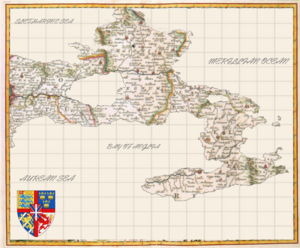History of Angland: Difference between revisions
| Line 22: | Line 22: | ||
===Stone Age Anglica=== | ===Stone Age Anglica=== | ||
[[File:SilburyHill_gobeirne.jpg|250px|thumb|left|Newbury Hill, one of Parthenia's largest artifical mounds.]] | [[File:SilburyHill_gobeirne.jpg|250px|thumb|left|Newbury Hill, one of Parthenia's largest artifical mounds.]] | ||
Angland contains evidence of being the first in the {{wp|western hemisphere}} to have been inhabited by humans, with the first traces of human life dating back to around 600,000 years ago, during the [[Great Hominid Migration]]. Continuous human habitation in Angland dates to around 13,000 years ago (see [[Angland#Prehistory|Wensley Man]]), at the end of the Last Glacial Period. This is commonly known by historians as the Old Stone Age, or {{wp|Paleolithic Era}}. Evidence suggest what was to become | Angland contains evidence of being the first in the {{wp|western hemisphere}} to have been inhabited by humans, with the first traces of human life dating back to around 600,000 years ago, during the [[Great Hominid Migration]]. Continuous human habitation in Angland dates to around 13,000 years ago (see [[Angland#Prehistory|Wensley Man]]), at the end of the Last Glacial Period. This is commonly known by historians as the Old Stone Age, or {{wp|Paleolithic Era}}. Evidence suggest what was to become Angland was colonised by humans long before the rest of the [[Anglican Peninsula]] due to it's hospitable climate and lack of apex predators. Evidence from caves suggest, however, that early humans in Angland had common contact with {{wp|cave bear}}s as damage to human and bear skeletons imply it was a commonality. [[File:Torquay2.jpg|220px|thumb|right|Chesterton Caverns, the location of stone age findings.]] | ||
By 6500 BC, as in the rest of the world, was exclusively anatomically modern humans, and the evidence suggests that their societies were increasingly complex and they were manipulating their environment and prey in new ways, possibly selective burning of then omnipresent woodland to create clearings for herds to gather and then hunt them. Early Anglican hunters would use projectiles and slings to hunt. Bow and arrow was known in Eastern Parthenia since at least 9000 BC, however it took longer for it to reach Angland with earliest evidence being around 7000 BC. The climate continued to warm and the population probably rose. | By 6500 BC, as in the rest of the world, was exclusively anatomically modern humans, and the evidence suggests that their societies were increasingly complex and they were manipulating their environment and prey in new ways, possibly selective burning of then omnipresent woodland to create clearings for herds to gather and then hunt them. Early Anglican hunters would use projectiles and slings to hunt. Bow and arrow was known in Eastern Parthenia since at least 9000 BC, however it took longer for it to reach Angland with earliest evidence being around 7000 BC. The climate continued to warm and the population probably rose. | ||
Revision as of 19:23, 30 January 2023
Part of a series on the |
|---|
| History of Angland |
 |
The history of Angland dates to contact the pre-Remillian peoples of the Aurean coast of the Anglican Peninsula made with the Remillians and Carcedonians and the first writing systems known as Paleoanglican scripts were developed. During Classical Antiquity, the peninsula was the site of multiple successive colonizations of Remillians, Anglo-Herulians and Wittekings. Native peoples of the peninsula, such as the Robergiais people, intermingled with the colonizers to create a uniquely Anglican culture. The Remillians referred to the entire Peninsula as Angligaullica, from where the modern name of Angland originates.
Prehistory
Stone Age Anglica
Angland contains evidence of being the first in the western hemisphere to have been inhabited by humans, with the first traces of human life dating back to around 600,000 years ago, during the Great Hominid Migration. Continuous human habitation in Angland dates to around 13,000 years ago (see Wensley Man), at the end of the Last Glacial Period. This is commonly known by historians as the Old Stone Age, or Paleolithic Era. Evidence suggest what was to become Angland was colonised by humans long before the rest of the Anglican Peninsula due to it's hospitable climate and lack of apex predators. Evidence from caves suggest, however, that early humans in Angland had common contact with cave bears as damage to human and bear skeletons imply it was a commonality.
By 6500 BC, as in the rest of the world, was exclusively anatomically modern humans, and the evidence suggests that their societies were increasingly complex and they were manipulating their environment and prey in new ways, possibly selective burning of then omnipresent woodland to create clearings for herds to gather and then hunt them. Early Anglican hunters would use projectiles and slings to hunt. Bow and arrow was known in Eastern Parthenia since at least 9000 BC, however it took longer for it to reach Angland with earliest evidence being around 7000 BC. The climate continued to warm and the population probably rose.

